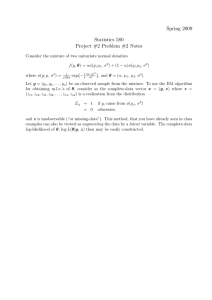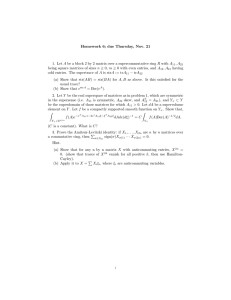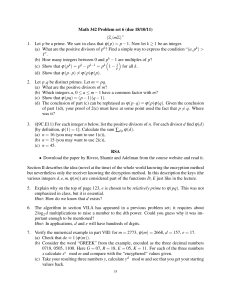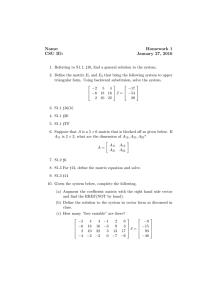Electric Circuits II Two-Port Circuits Interconnected Two
advertisement
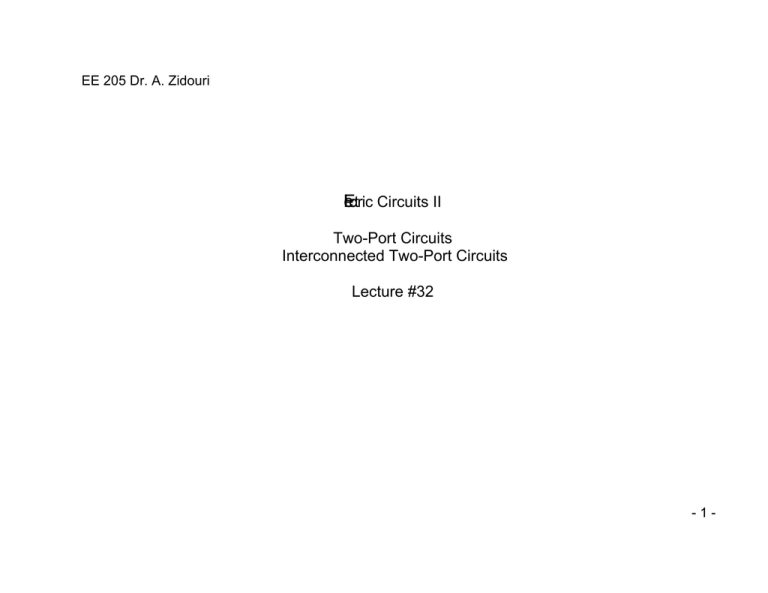
EE 205 Dr. A. Zidouri E e l ctric Circuits II Two-Port Circuits Interconnected Two-Port Circuits Lecture #32 -1- EE 205 Dr. A. Zidouri The material to be covered in this lecture is as follows: o o o o Terminated Two-Port circuit Terminal Behavior The Six characteristics of the terminated two-port circuit in terms of z parameters Interconnected Two-Port Circuits After finishing this lecture you should be able to: ¾ ¾ ¾ ¾ Analyze The Terminated Two-Port circuit Determine The characteristics of the terminated circuit in terms of z parameters Recognize the different Interconnection of the Two-Port Circuits Analyze The Cascade Connection -2- EE 205 Dr. A. Zidouri T e rm n ia td w o -P C cu The Circuit is driven at port 1 and loaded at port 2 A typically terminated two-port model is shown in Fig. 44-1 i1 i2 Zg v1 Vg v2 ZL Fig. 44-1 A Terminated Two-Port Model Zg represents the internal impedance of the source ZL represents the Load impedance Vg represents the internal voltage of the source Analysis of this circuit involves expressing the terminal currents and voltages as function of Vg, ZL, and Zg. Terminal Behavior: Six characteristics of the terminated two-port circuit define its terminal behavior. 1. The input impedance 2. The output current Z in = V1 I or admittance Yin = 1 I1 V1 I2 3. Thevenin voltage and impedance (V Th , Z Th ) with respect to port 2 -3- EE 205 Dr. A. Zidouri I2 I1 V 5. The voltage gain 2 V1 V 6. The current gain 2 Vg 4. The current gain The six characteristics in Terms of the z Parameters: We develop the expressions using the z-parameters to model the two-port portion of the circuit. Expressions involving other parameters y, a, b, h and g can be found in tables in text books. The derivation of any one of the desired expressions involves the algebraic manipulation of the two-port equations along with the two constraint equations. These four equations using z parameters are: (44-1) i. V1 = z11 I1 + z12 I 2 V2 = z21 I1 + z22 I 2 iii. V1 = Vg − I1 Z g iv. V2 = − I 2 Z L ii. To find the input impedance Z in = (44-2) (44-3) (44-4) V1 we proceed as follows: I1 -4- EE 205 Dr. A. Zidouri In (44-2) we replace V2 from (44-4) we solve for I2 we get: We then substitute in (44-1) and solve for Zin we get: − z21 I1 Z L + z22 z z Z in = z11 − 12 21 z22 + Z L I2 = (44-5) (44-6) To find I2 we first solve (44-5) for I1 after replacing V1 with the RHS of (44-3) the result is: I1 = Vg − z12 I 2 (44-7) Z g + z11 We now substitute (44-7) into (44-5) and solve for I2: I2 = (Z − z21Vg g + z11 ) ( Z L + z22 ) − z12 z21 (44-8) The Thevenin voltage with respect to port 2 equals V2 when I2 = 0. Therefore: V2 But V1 = Vg − I1 Z g , and I1 = I2 =0 Vg Z g + z11 = z21 I1 = z21 V1 z11 (44-9) when I2=0; therefore by substitution into (44-9) the open circuit value of V2 is: -5- EE 205 Dr. A. Zidouri z21 Vg (44-10) I =0 Z g + z11 V The Thevenin or output impedance is the ratio Z Th = 2 when Vg is zero (short circuit). Thus (44-3) I2 becomes V1 = − I1 Z g (44-11) − z12 I 2 (44-12) Substituting gives I1 = Z g + z11 V2 Therefore V2 I2 = Z Th = z22 − Vg = 0 2 = VTh = z12 z21 Z g + z11 The current gain comes directly from (44-5): (44-13) I2 − z21 = I1 Z L + z22 (44-14) V2 we replace I2 in (44-2) with its value from (44-4): V1 ⎛ −V ⎞ V2 = z21 I1 + z22 ⎜ 2 ⎟ (44-15) ⎝ ZL ⎠ To derive the voltage gain Next we solve (44-2) for I1 in terms of V1 and V2: -6- EE 205 Dr. A. Zidouri ⎛ −V ⎞ z11 I1 = V1 − z12 ⎜ 2 ⎟ ⎝ ZL ⎠ Or I1 = V1 z12V2 + z11 z11 Z L (44-16) Replace I1 in (44-15) and solve: V2 z21 Z L z21 Z L = = (44-17) V1 z11 Z L + z11 z22 − z12 z21 z11 Z L + ∆z V To derive the voltage gain 2 we first find I1 in terms of V1 and V2 by combining Vg (44-1), (44-3) and (44-4): I1 = Vg z11 + Z g + z12V2 Z L ( z11 + Z g ) (44-18) Then using (44-3) and (44-18) with (44-2) we derive an expression involving only V2 and Vg: V2 = zV z21 z12V2 z + 21 g − 22 V2 Z L ( z11 + Z g ) z11 + Z g Z L (44-19) -7- EE 205 Dr. A. Zidouri After manipulation we get: V2 z21 Z L = Vg ( z11 + Z g ) ( z22 + Z L ) − z12 z21 (44-20) Example 44-1 The two-port circuit of Fig. 44-2 is described in terms of its b parameters, the values of which are: b11 = −20 , b12 = −3k Ω , b21 = −2mS , and b22 = −0.2 a) Find the phasor voltage V2 b) Find the average power delivered to the 5kΩ load c) Find the average power delivered to the input port d) Find the load impedance for maximum average power transfer e) Find the maximum average power delivered to the load in (d) 500Ω 500∠0o 5kΩ -8- EE 205 Dr. A. Zidouri Solution: a) To find V2, we can either use (44-4) or from the voltage gain in (44-20), using the latter approach and conversion tables: ∆b = ( −20 )( −0.2 ) − ( −3000 )( −0.002 ) = −2 V2 z21 Z L = Vg ( z11 + Z g ) ( z22 + Z L ) − z12 z21 ( −2 )( 5000 ) ∆bZ L = b12 + b11 Z g + b22 Z L + b21 Z g Z L −3000 + ( −20 )( 500 ) + ( −0.2 )( 5000 ) + ( −0.002 )( 500 )( 5000 ) 10 10 = Then, V2 = 500 = 263.16∠0o V 19 19 = 5000Ω load is 263.162 P2 = = 6.93W 2 × 5000 b) The average power delivered to the c) To find average power delivered to the input port, we first find the input impedance Zin, From tables, Z in = b22 Z L + b12 ( −0.2 )( 5000 ) − 3000 = = 133.33Ω b11 + b21 Z L ( −0.002 )( 5000 ) − 20 -9- EE 205 Dr. A. Zidouri 500 = 789.47 mA 500 + 133.33 0.78947 2 The average power delivered to the input port is P1 = 133.33 = 41.55W 2 I1 = Therefore I1 is d) The total impedance for maximum power transfer ZL is the conjugate of Thevenin impedance. Z Th = b11 Z g + b12 b22 + b21 Z g ∗ Therefore Z L = Z Th = 10833.33Ω = ( −20 )( 500 ) − 3000 = 10833.33Ω ( −0.002 )( 500 ) − 0.2 e) To find the maximum average power delivered to the load, we first find V2 from the gain expression when Z L = 10833.33Ω V2 1 416.67 2 = 8.01W = 0.8333 thus V2 = 0.8333 × 500 = 416.67V and P2max = V1 2 10833.33 - 10 - EE 205 Dr. A. Zidouri In te rco d w T -P C its u Two-port circuits may be interconnected in five ways: 1) In Cascade Fig. 44-3a 2) In Series Fig. 44-3b 3) In Parallel Fig. 44-3c 4) In Series-Parallel Fig. 44-3d 5) In Parallel-Series Fig. 44-3e a b a11' a12' a21' a22' c a11" a12" a21" a22" d e Fig. 44-3 Five Basic Interconnections (a) Cascade (b) Series (c) Parallel (d) Series-Parallel (e) Parallel-Series - 11 - EE 205 Dr. A. Zidouri We analyze only the Cascade connection because it occurs frequently in the modeling of large systems. The a-parameters are best suited for describing cascade connection We seek the pair of equations: V1 = a11V2 − a12 I 2 (44-1) I1 = a21V2 − a22 I 2 (44-2) From Fig. 44-4 we have V1 = a11' V2' − a12' I 2' (44-3) I1 = a21' V2' − a22' I 2' (44-4) ' ' ' ' From interconnection V2 = V1 and I 2 = − I1 , then substituting yields: V1 = a11' V1 ' − a12' I1' (44-5) I1 = a21' V1 ' − a22' I1' (44-6) From the second circuit V1 ' = a11" V2 − a12" I 2 I 2' = a21" V2 − a22" I 2 (44-7) (44-8) By substitution we generate V1 = ( a11' a11" + a12' a12" )V2 − ( a11' a12" + a12' a22" ) I 2 I1 = ( a21' a11" + a22' a21" )V2 − ( a21' a12" + a22' a22" ) I 2 (44-9) (44-10) - 12 - EE 205 Dr. A. Zidouri By comparison we get the desired expressions: a11 = a11' a11" + a12' a12" a12 = a11' a12" + a12' a22" a21 = a21' a11" + a22' a21" a22 = a21' a12" + a22' a22" (44-11) (44-12) (44-13) (44-14) Self Test 44: Find the transmission parameters for the circuit in Fig. 44-5 Fig. 44-5 The Circuit for Self Test 44 Answer: ⎡5 44 ⎤ ⎡ 1 6 ⎤ ⎡ 27 T T T = = =⎢ [ ] [ 1 ][ 2 ] ⎢ ⎥ ⎢ ⎥ ⎣1 9 ⎦ ⎣0.5 4 ⎦ ⎣5.5S 206Ω ⎤ 42 ⎥⎦ - 13 - EE 205 Dr. A. Zidouri i.e. a11 = 27 a12 = 206Ω a21 = 5.5S a22 = 42 PC = VCN . I cC .Cos (θVC − θ iC ) a12 = 206Ω a12 = 206Ω a12 = 206Ω a12 = 206Ω - 14 -


